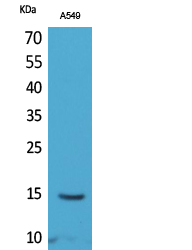Histone H2B (Acetyl Lys126) Polyclonal Antibody
- SPECIFICATION
- CITATIONS
- PROTOCOLS
- BACKGROUND

Application
| WB |
|---|---|
| Primary Accession | Q96A08 |
| Reactivity | Human, Mouse, Rat |
| Host | Rabbit |
| Clonality | Polyclonal |
| Calculated MW | 14167 Da |
| Gene ID | 255626 |
|---|---|
| Other Names | HIST1H2BA; TSH2B; Histone H2B type 1-A; Histone H2B, testis; Testis-specific histone H2B; HIST1H2BB; H2BFF; Histone H2B type 1-B; Histone H2B.1; Histone H2B.f; H2B/f; HIST1H2BC; H2BFL; HIST1H2BE; H2BFH; HIST1H2BF;H2BFG; HIST1H2BG; H2BFA; HIST1H2BI; H2BFK; Histone H2B type 1-C/E/F/G/I; Histone H2B.1 A; Histone H2B.a; H2B/a; Histone H2B.g; H2B/g; Histone H2B.h; H2B/h; Histone H2B.k; H2B/k; Histone H2B.l; H2B/l |
| Dilution | WB~~Western Blot: 1/500 - 1/2000. ELISA: 1/20000. Not yet tested in other applications. |
| Format | Liquid in PBS containing 50% glycerol, 0.5% BSA and 0.09% (W/V) sodium azide. |
| Storage Conditions | -20℃ |
| Name | H2BC1 (HGNC:18730) |
|---|---|
| Function | Variant histone specifically required to direct the transformation of dissociating nucleosomes to protamine in male germ cells (By similarity). Entirely replaces classical histone H2B prior nucleosome to protamine transition and probably acts as a nucleosome dissociating factor that creates a more dynamic chromatin, facilitating the large-scale exchange of histones (By similarity). Core component of nucleosome (By similarity). Nucleosomes wrap and compact DNA into chromatin, limiting DNA accessibility to the cellular machineries which require DNA as a template (By similarity). Histones thereby play a central role in transcription regulation, DNA repair, DNA replication and chromosomal stability (By similarity). DNA accessibility is regulated via a complex set of post-translational modifications of histones, also called histone code, and nucleosome remodeling (By similarity). Also found in fat cells, its function and the presence of post-translational modifications specific to such cells are still unclear (PubMed:21249133). |
| Cellular Location | Nucleus {ECO:0000250|UniProtKB:P70696}. Chromosome {ECO:0000250|UniProtKB:P70696} |
| Tissue Location | Mainly expressed in testis, and the corresponding protein is also present in mature sperm (at protein level). Also found in some fat cells. |

Thousands of laboratories across the world have published research that depended on the performance of antibodies from Abcepta to advance their research. Check out links to articles that cite our products in major peer-reviewed journals, organized by research category.
info@abcepta.com, and receive a free "I Love Antibodies" mug.
Provided below are standard protocols that you may find useful for product applications.
Background
Variant histone specifically required to direct the transformation of dissociating nucleosomes to protamine in male germ cells (By similarity). Entirely replaces classical histone H2B prior nucleosome to protamine transition and probably acts as a nucleosome dissociating factor that creates a more dynamic chromatin, facilitating the large-scale exchange of histones (By similarity). Core component of nucleosome (By similarity). Nucleosomes wrap and compact DNA into chromatin, limiting DNA accessibility to the cellular machineries which require DNA as a template (By similarity). Histones thereby play a central role in transcription regulation, DNA repair, DNA replication and chromosomal stability (By similarity). DNA accessibility is regulated via a complex set of post-translational modifications of histones, also called histone code, and nucleosome remodeling (By similarity). Also found in fat cells, its function and the presence of post-translational modifications specific to such cells are still unclear (PubMed:21249133).
If you have used an Abcepta product and would like to share how it has performed, please click on the "Submit Review" button and provide the requested information. Our staff will examine and post your review and contact you if needed.
If you have any additional inquiries please email technical services at tech@abcepta.com.













 Foundational characteristics of cancer include proliferation, angiogenesis, migration, evasion of apoptosis, and cellular immortality. Find key markers for these cellular processes and antibodies to detect them.
Foundational characteristics of cancer include proliferation, angiogenesis, migration, evasion of apoptosis, and cellular immortality. Find key markers for these cellular processes and antibodies to detect them. The SUMOplot™ Analysis Program predicts and scores sumoylation sites in your protein. SUMOylation is a post-translational modification involved in various cellular processes, such as nuclear-cytosolic transport, transcriptional regulation, apoptosis, protein stability, response to stress, and progression through the cell cycle.
The SUMOplot™ Analysis Program predicts and scores sumoylation sites in your protein. SUMOylation is a post-translational modification involved in various cellular processes, such as nuclear-cytosolic transport, transcriptional regulation, apoptosis, protein stability, response to stress, and progression through the cell cycle. The Autophagy Receptor Motif Plotter predicts and scores autophagy receptor binding sites in your protein. Identifying proteins connected to this pathway is critical to understanding the role of autophagy in physiological as well as pathological processes such as development, differentiation, neurodegenerative diseases, stress, infection, and cancer.
The Autophagy Receptor Motif Plotter predicts and scores autophagy receptor binding sites in your protein. Identifying proteins connected to this pathway is critical to understanding the role of autophagy in physiological as well as pathological processes such as development, differentiation, neurodegenerative diseases, stress, infection, and cancer.

.jpg)

